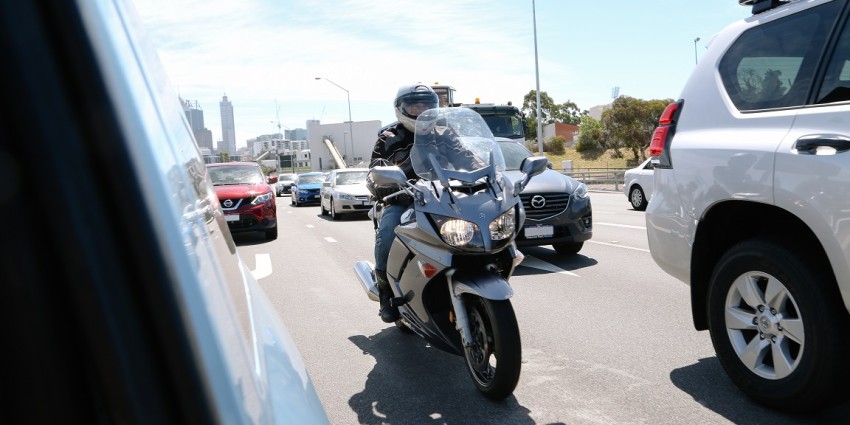Motorcycle Lane Filtering review, November 2023
On 29 March 2021, amendments to the Road Traffic Code 2000 came into effect to permit motorcycle lane filtering in certain circumstances.
Over 18 months after the amendments came into effect, the Road Safety Commission conducted a review, in order to assess the practical effects of the amendments. This is a summary of the findings.
Motorcycle Lane Filtering review
Lane filtering
Lane filtering is a manoeuvre where a motorcycle rider travels at low speed – no more than 30 km/h – between two lanes of stationary or slow-moving vehicles travelling in the same direction. Riding between lanes of traffic at more than 30 km/h is illegal.
Western Australia’s motorcycle lane filtering legislation (Road Traffic Code 2000 r.130A) has been designed with the safety of motorcycle riders and all other road users in mind.
A penalty of $100 and 2 demerit points apply to riders who do not follow lane filtering rules.
To get a clear sign of what is and isn't permitted when lane filtering on WA roads, watch the video below.
Frequently asked questions about lane filtering
Can lane filtering motorcyclists ride on continuous lines?
Yes. Motorcycle riders can ride on and over continuous white lines separating lanes of traffic moving in the same direction while lane filtering. This will allow them to ride between lanes to stop at the front of the intersection where it is safe to do so.
Why aren’t lane filtering motorcyclists allowed to travel at more than 30 km/h?
Riding between lanes at more than 30 km/h increases the crash risk for the motorcyclist and other road users. Limiting lane filtering speeds to 30 km/h and below is consistent with the approach for safe riding throughout Australia.
What about pedestrian safety?
Pedestrians may try to cross the road when there are stationary or slow moving vehicles, and may not expect lane filtering motorcycles. To minimise the risk of harm to pedestrians, lane filtering is not allowed between a line of traffic and the kerb. Lane filtering is also prohibited next to the edge of the road or parked cars.
To ensure pedestrian safety, motorcyclists are also prohibited from lane filtering at more than 30 km/h. This is because the relationship between speed and injury severity is particularly critical for pedestrians. For instance, pedestrians have a 90% chance of survival when struck by a vehicle travelling at 30 km/h or below, but less than a 50% chance of surviving a collision at 45 km/h.
Where is lane filtering prohibited?
Lane filtering is a complex and potentially risky manoeuvre which should only be conducted in low risk traffic situations. For safety reasons, lane filtering is prohibited where –
- the rider is approaching or riding on a children’s crossing, marked foot crossing or pedestrian crossing;
- the rider is in a school zone or shared zone;
- the applicable speed limit is 40 km/h or below;
- the rider is between one or more heavy vehicles;
- the vehicles the rider is riding between are merging;
- no overtaking is allowed;
- the rider is in a roundabout;
- the rider is riding in or next to a bicycle lane, bus lane or other special purpose lane;
- the rider is next to the kerb or edge of the road, or alongside parked cars;
- it is unsafe in the circumstances to lane filter.
Why can’t motorcyclists lane filter in areas where the speed limit is 40 km/h or below?
Roads are speed limited to 40 km/h and below where there are high levels of pedestrian activity (e.g. near shops and cafes) and where particular care needs to be taken (e.g. at roadworks, school zones, shared zones, pedestrian priority zones, and where there is a stationary emergency vehicle with flashing lights). In the interests of safety, lane filtering is prohibited in these areas.
Why can’t motorcyclists lane filter in roundabouts?
Motorcyclists are already overrepresented in serious and fatal crashes at roundabouts. Allowing motorcyclists to lane filter in roundabouts will increase the risk of a crash.
Why can’t motorcyclists lane filter beside heavy vehicles?
Heavy vehicles and their drivers often have difficulty spotting motorcyclists. This makes it unsafe to ride between one or more heavy vehicles. For this rule a heavy vehicle is a vehicle other than a bus which has (together with any attached trailers or loads) a GCM of 22.5t or more. Examples of a heavy vehicle include semi-trailers, trucks, or road trains.
Are motorcyclists riding under a learner permit allowed to lane filter?
No. Lane filtering requires a high level of riding ability, road awareness and hazard perception, and is difficult for inexperienced riders to do safely.
Are all motorcycles allowed to lane filter?
No. Motorcycles with a sidecar and motorcycles with three wheels are not allowed to lane filter.
Do the lane filtering laws apply to cyclists?
No. Lane filtering laws apply to riders of motorcycles only. For rules and penalties that apply to cyclists, please visit the cyclists page.



